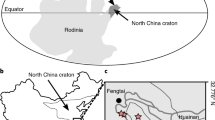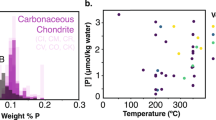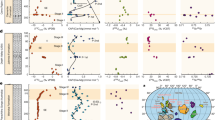Abstract
After the evolution of oxygen-producing cyanobacteria at some time before 2.7 billion years ago1, oxygen production on Earth is thought to have depended on the availability of nutrients in the oceans, such as phosphorus (in the form of orthophosphate). In the modern oceans, a significant removal pathway for phosphorus occurs by way of its adsorption onto iron oxide deposits2,3. Such deposits were thought to be more abundant in the past when, under low sulphate conditions, the formation of large amounts of iron oxides resulted in the deposition of banded iron formations4,5. Under these circumstances, phosphorus removal by iron oxide adsorption could have been enhanced. Here we analyse the phosphorus and iron content of banded iron formations to show that ocean orthophosphate concentrations from 3.2 to 1.9 billion years ago (during the Archaean and early Proterozoic eras) were probably only ∼10–25% of present-day concentrations. We suggest therefore that low phosphorus availability should have significantly reduced rates of photosynthesis and carbon burial, thereby reducing the long-term oxygen production on the early Earth—as previously speculated4—and contributing to the low concentrations of atmospheric oxygen during the late Archaean and early Proterozoic.
This is a preview of subscription content, access via your institution
Access options
Subscribe to this journal
Receive 51 print issues and online access
$199.00 per year
only $3.90 per issue
Buy this article
- Purchase on Springer Link
- Instant access to full article PDF
Prices may be subject to local taxes which are calculated during checkout



Similar content being viewed by others
References
Brocks, J. J., Logan, G. A., Buick, R. & Summons, R. E. Archean molecular fossils and the early rise of eukaryotes. Science 285, 1033–1036 (1999)
Berner, R. A. Phosphate removal from sea water by adsorption on volcanogenic ferric oxides. Earth Planet. Sci. Lett. 18, 77–86 (1973)
Wheat, C. G., Feely, R. A. & Mottl, M. J. Phosphate removal by oceanic hydrothermal processes: An update of the phosphorus budget in the oceans. Geochim. Cosmochim. Acta 19, 3593–3608 (1996)
Holland, H. D. The Chemical Evolution of the Atmosphere and Oceans (Princeton Univ. Press, New York, 1984)
Canfield, D. E. A new model for Proterozoic ocean chemistry. Nature 396, 450–453 (1998)
Stumm, W. & Morgan, J. J. Aquatic Chemistry: An Introduction Emphasizing Chemical Equilibria in Natural Waters (Wiley & Sons, New York, 1981)
Feely, R. A., Trefry, J. H., Lebon, G. T. & German, C. R. The relationship between P/Fe and V/Fe ratios in hydrothermal precipitates and dissolved phosphate in seawater. Geophys. Res. Lett. 25, 2253–2256 (1998)
Beukes, N. J., Klein, C., Kaufman, A. J. & Hayes, J. M. Carbonate petrography, kerogen distribution, and carbon and oxygen isotope variations in an early Proterozoic transition from limestone to iron-formation deposition, Transvaal Supergroup, South Africa. Econ. Geol. 85, 663–690 (1990)
Kaufman, A. J., Hayes, J. M. & Klein, C. Primary and diagenetic controls of isotopic compositions of iron-formation carbonates. Geochim. Cosmochim. Acta 54, 3461–3473 (1990)
Walker, J. C. G. Suboxic diagenesis in banded iron formations. Nature 309, 340–342 (1984)
Schaller, T., Morford, J., Emerson, S. R. & Feely, R. A. Oxyanions in metalliferous sediments: Tracers for paleoseawater metal concentrations. Geochim. Cosmochim. Acta 63, 2243–2254 (2000)
Compton, J. et al. in Marine Authigenesis; From Global to Microbial (eds Glenn, C. R., Prevot, L. L. & Lucas, J.) 21–33 (Society for Sedimentary Geology, Tulsa, 2000)
Filippelli, G. M. Carbon and phosphorus cycling in anoxic sediments of the Saanich Inlet, British Columbia. Mar. Geol. 174, 307–321 (2001)
Van Cappellen, P. & Ingall, E. D. Redox stabilization of the atmosphere and oceans by phosphorus-limited marine productivity. Science 271, 493–496 (1996)
Anderson, L. D., Delaney, M. L. & Faul, K. L. Carbon to phosphorus ratios in sediments: Implications for nutrient cycling. Glob. Biogeochem. Cycles 15, 65–79 (2001)
Roden, E. E. & Edmonds, J. W. Phosphate mobilization in iron-rich anaerobic sediments: Microbial Fe(III) oxide reduction versus iron-sulfide formation. Archiv. Hydrobiol. 139, 347–378 (1997)
Fralick, P. & Barrett, T. J. in Sedimentary Facies Analysis; A Tribute to the Research and Teaching of Harold G. Reading (ed. Plint, A. G.) 137–156 (Special Publication of the International Association of Sedimentologists, Oxford, 1995)
de Ronde, C. E. J., Channer, D. M., De, R., Faure, K., Bray, C. J. & Spooner, E. T. C. Fluid chemistry of Archean seafloor hydrothermal vents: Implication for the composition of circa 3.2 Ga seawater. Geochim. Cosmochim. Acta 61, 4025–4042 (1997)
Klein, C. & Beukes, N. J. Geochemistry and sedimentology of a facies transition from limestone to iron-formation deposition in the early Proterozoic Transvaal Supergroup, South Africa. Econ. Geol. 84, 1733–1774 (1989)
Karhu, J. A. & Holland, H. D. Carbon isotopes and the rise of atmospheric oxygen. Geology 24, 867–870 (1996)
Shaffer, G. A model of biogeochemical cycling of phosphorous, nitrogen, oxygen, and sulphur in the ocean: One step toward a global climate model. J. Geophys. Res. 94, 1979–2004 (1989)
Lenton, T. M. & Watson, A. J. Redfield revisited 2. What regulates the oxygen content of the atmosphere? Glob. Biogeochem. Cycles 14, 249–268 (2000)
Holland, H. D. The Chemistry of the Atmosphere and Oceans (Wiley, New York, 1978)
Canfield, D. E., Habicht, K. S. & Thamdrup, B. The archean sulfur cycle and the early history of atmospheric oxygen. Science 288, 658–661 (2000)
Des Marais, D. J. Isotopic evolution of the biogeochemical carbon cycle during the Proterozoic eon. Org. Geochem. 27, 185–193 (1997)
Sleep, N. H. & Zahnle, K. Carbon dioxide cycling and implications for climate on ancient Earth. J. Geophys. Res. 106, 1373–1399 (2001)
Des Marais, D. J., Strauss, H., Summons, R. E. & Hayes, J. M. Carbon isotope evidence from the stepwise oxidation of the Proterozoic environment. Nature 359, 605–609 (1992)
Isley, A. E. & Abbott, D. H. Plume-related mafic volcanism and the deposition of banded iron formation. J. Geophys. Res. 104, 15461–15477 (1999)
Anbar, A. D. & Knoll, A. H. Trace metal limitation of primary production 1.85–1.25 Ga. (American Geophysical Union Fall Meeting, 1999); available at http://www.agu.org/meetings/fm99top.html
Berner, E. K. & Berner, R. A. The Global Water Cycle, Geochemistry and Environment (Prentice Hall, New Jersey, 1994)
Acknowledgements
We thank J. Hayes and T. Lenton for comments and suggestions. This work was funded by the Danish National Research Foundation (Danmarks Grundforskingsfond) and the Danish National Science Foundation (SNF).
Author information
Authors and Affiliations
Corresponding author
Ethics declarations
Competing interests
The authors declare that they have no competing financial interests.
Supplementary information
Rights and permissions
About this article
Cite this article
Bjerrum, C., Canfield, D. Ocean productivity before about 1.9 Gyr ago limited by phosphorus adsorption onto iron oxides. Nature 417, 159–162 (2002). https://doi.org/10.1038/417159a
Received:
Accepted:
Issue Date:
DOI: https://doi.org/10.1038/417159a
This article is cited by
-
A phosphate-rich marine reservoir in the redox stratified Ediacaran ocean
Communications Earth & Environment (2024)
-
Integrated Stratigraphy and Mineralogy of the Doushantuo Formation in Weng’an, South China, and Implications for Ediacaran Phosphogenesis
Journal of Earth Science (2024)
-
Phosphate availability and implications for life on ocean worlds
Nature Communications (2023)
-
Oxygenation of the Earth aided by mineral–organic carbon preservation
Nature Geoscience (2023)
-
Uncovering the Ediacaran phosphorus cycle
Nature (2023)
Comments
By submitting a comment you agree to abide by our Terms and Community Guidelines. If you find something abusive or that does not comply with our terms or guidelines please flag it as inappropriate.



